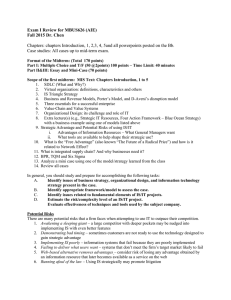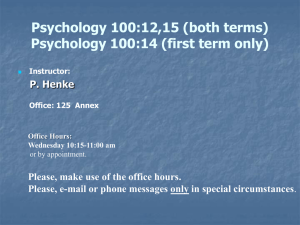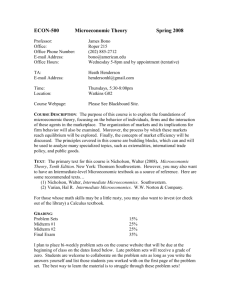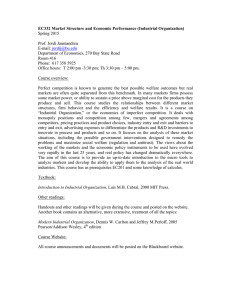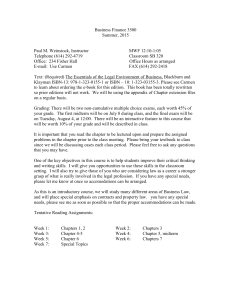EC201 B Intermediate Microeconomic Analysis Prof. Jordi Jaumandreu E-mail:
advertisement
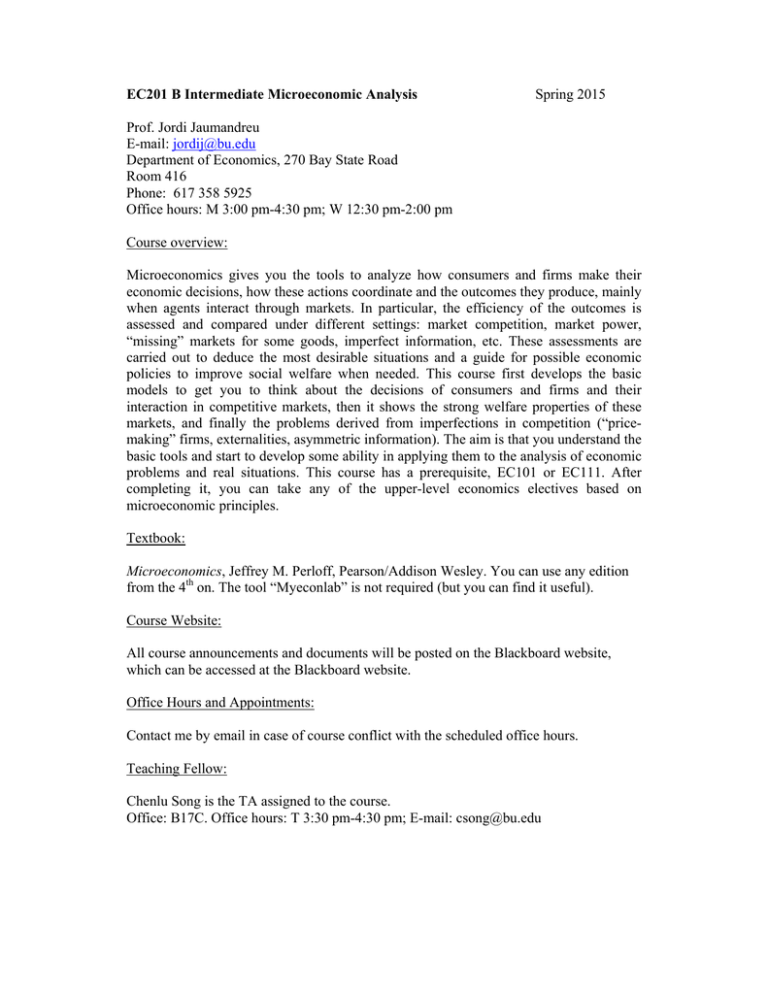
EC201 B Intermediate Microeconomic Analysis Spring 2015 Prof. Jordi Jaumandreu E-mail: jordij@bu.edu Department of Economics, 270 Bay State Road Room 416 Phone: 617 358 5925 Office hours: M 3:00 pm-4:30 pm; W 12:30 pm-2:00 pm Course overview: Microeconomics gives you the tools to analyze how consumers and firms make their economic decisions, how these actions coordinate and the outcomes they produce, mainly when agents interact through markets. In particular, the efficiency of the outcomes is assessed and compared under different settings: market competition, market power, “missing” markets for some goods, imperfect information, etc. These assessments are carried out to deduce the most desirable situations and a guide for possible economic policies to improve social welfare when needed. This course first develops the basic models to get you to think about the decisions of consumers and firms and their interaction in competitive markets, then it shows the strong welfare properties of these markets, and finally the problems derived from imperfections in competition (“pricemaking” firms, externalities, asymmetric information). The aim is that you understand the basic tools and start to develop some ability in applying them to the analysis of economic problems and real situations. This course has a prerequisite, EC101 or EC111. After completing it, you can take any of the upper-level economics electives based on microeconomic principles. Textbook: Microeconomics, Jeffrey M. Perloff, Pearson/Addison Wesley. You can use any edition from the 4th on. The tool “Myeconlab” is not required (but you can find it useful). Course Website: All course announcements and documents will be posted on the Blackboard website, which can be accessed at the Blackboard website. Office Hours and Appointments: Contact me by email in case of course conflict with the scheduled office hours. Teaching Fellow: Chenlu Song is the TA assigned to the course. Office: B17C. Office hours: T 3:30 pm-4:30 pm; E-mail: csong@bu.edu Attendance: Students are expected to attend all lectures. Each lecture will build on the knowledge acquired in the previous one and, if you miss a class, you are responsible for getting the lecture notes from your classmates. Class Preparation, Participation and Assignments: The ideal way to learn is to read the assigned chapters before lectures, attend the class and ask questions during the lecture, and to study the chapter and notes after the lecture, at the same time working on the solution of the assigned set of problems. There will be about 10 problem sets. Selected problems will be solved and discussed in class and all solutions posted. Students are encouraged to form small groups to work on the assignments, but you must take into account that the final aim is to develop the ability to solve the problems by yourself. Assignments will not be graded. Exams and Grading: Exams will be based on problems similar to those assigned during the course in the problem sets. Notice that these problems often include one or more short essay questions. Course grades will be based on two midterm exams and a cumulative final exam. In principle, each midterm will count for 25% of the final grade and the final exam 50%, but if a student’s score on the final exam is higher than the average of the midterms, these weights will be updated to 15%, 15% and 70%. Especial situations: There will be no makeup exams. Any student who goes through an especial situation (e.g. medical emergency) must report the situation by email before the exam takes place and contact me as soon as possible to set a solution. Academic Conduct: It is the student’s responsibility to understand and observe the CAS Academic Conduct Code. The code is available at http://www.bu.edu/academics/resources/academicconduct-code. Course outline: Minor changes might be made during the course. They will be announced at class and posted on the Website. Many of the book chapters are not required in their entirety. Introduction: Microeconomics and Models (Chapter 1) Background: Some Mathematical Concepts and Definitions (PS #1) Review: Demand and Supply, Applications (Chapters 2 and 3, PS #2) Consumer Theory (Chapters 4 and 5) Preferences, Utility, Constrained Choice and Equilibrium (PS #3) Consumer Demand, Price and Income Changes (PS #4) Labor Supply Theory of the Firm (Chapters 6 and 7) Production Function, One and Two-Variable Factors, Returns to Scale (PS #5) Cost Function, Short Run/Long Run costs (PS #6) Profit Maximization and Competition Midterm Exam 1: Friday, February 27 Competitive Markets (Chapter 8, PS #7) Market Demand and Supply, Short Run/Long Run General Equilibrium and Welfare (Chapters 9 and 10, PS #8) Measuring Welfare, Competition Maximizes Welfare Applying Welfare Analysis Interaction of Competitive Markets, General Equilibrium Monopoly, Pricing (Chapters 11 and 12, PS #9) Monopoly Profit Maximization, Market Power Effects, Sources, and Remedies Price discrimination: Perfect, Multimarket and Two-Part Tariffs. Midterm Exam 2: Wednesday, April 1 Oligopoly, Strategy (Chapters 13 and 14, Ps #10) Oligopoly, Cournot Competition, Bertrand Pricing Collusion Entry into a Market Externalities (Chapter 18, PS #11) Inefficiency of Competition and Remedies for the Effects Public Goods Asymmetric Information (Chapter 19, PS #12) Moral Hazard and Adverse Selection. Final Exam: Tuesday, May 5, 3:00 am –5:00 am
